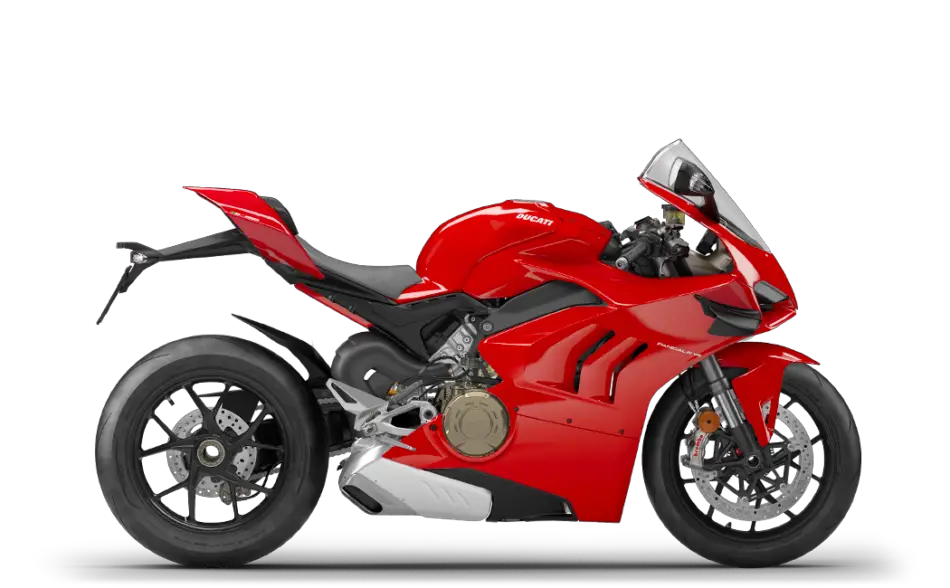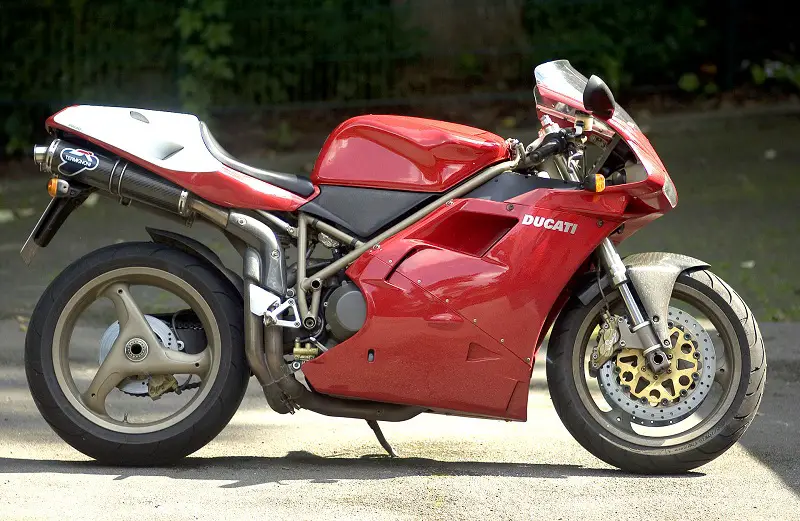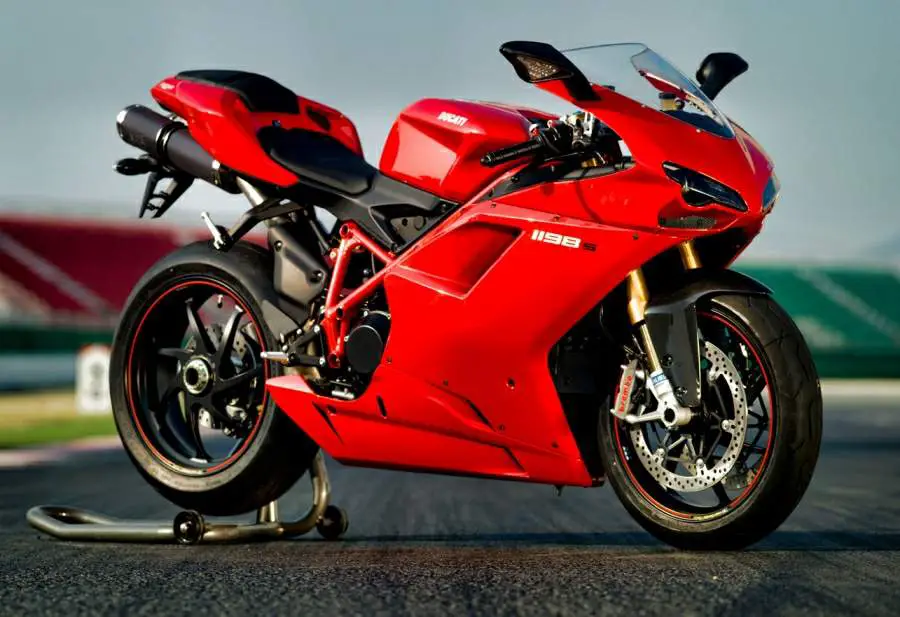If you want a boring reliable bike, buy Japanese. If its fun and admiration you’re after and you don’t mind the shoddy reliability, get yourself an Italian motorcycle. Or so the stereotype goes. I don’t even know why I know this, so I dug around to find out whether Italian bikes really are as unreliable as ‘everyone‘ says.
Italian bike brand Ducati ranked 8th in terms of reliability in a survey of more than 12 300 motorcycles conducted by Consumer Reports. Italian Ducati and Aprilia had some of the dirtiest first-service oil samples in a lab test done by Fortnine, suggesting poor build quality.
To establish which bikes are reliable in the long-term, there are so many variables involved that the results are hardly going to be scientific or conclusive. So let’s look at what we do know.
Research on motorcycle reliability
Accurate, up to date data on motorcycle reliability is hard to come by and the best we can do is look at a study from Consumer Reports. This independent, non-profit organization does research to inform purchase decisions and protect consumers. In a survey of their subscribers, they received feedback on more than 12 300 motorcycles from model years 2008 to 2014. The results of repair rates for 4-year-old models without a service contract were estimated after being adjusted for mileage driven over a 12-month period.

Unsurprisingly, and confirming the stereotype, the four Japanese brands topped the list with the least reported faults within the first four years of ownership. Next came the American brands, Victory and Harley Davidson, followed by English Triumph. The first Italian motorcycle on the list was Ducati in 8th place with 33% of new bikes experiencing some mechanical problems in the first 4 years. Bad as that may seem, it beat the German BMW, a brand that does not have the same perception of poor reliability as the Italian bikes.
In 2020 Dave Kapaun from TheThings ranked the 9 most reliable bike brands (and the 6 least reliable) of 2020. At least on this list Italian-brand Ducati made it on the list of best bike brands – even though it scraped in dead last of the best. According to Kapaun, the brand had a reputation for ‘poor reliability and extremely expensive maintenance costs’. Apparently most of these problems have recently been corrected.
Aprilia, another Italian brand, came in as the third worst motorcycle brand on this list with Kapaun highlighting it as a ‘temperamental European brand with spotty dealer support and questionable reliability’. Just below Aprilia on this list is Italian-brand Moto Guzzi, coming in just before the Royal Enfield that was listed as the worst brand in terms of reliability. Kapaun added that Moto Guzzi ‘may spend a lot of time in the shop’.
It is important to remember that mechanical issues can develop as a result of many different factors. Unfortunately, the article does not list any credible sources, so we need to dig a bit deeper.
Oil sample test by FortNine – How did the Italians do?
To confirm the reliability (or at least the build quality) of Italian motorcycles, what we really need is empirical evidence. This is what Ryan F9 from the FortNine YouTube channel attempted, albeit with a sample size of one (of each of the nine bike brands).
FortNine collected first service oil samples from owners of 12 brand new motorcycles from different brands. These samples were sent to a major car manufacturer in Europe to be scientifically analyzed in a lab to test the cleanliness of the oil. The lab’s microscopes and software counts the number of particles of various sizes in the oil. The purity of the first-service oil is an indication of the quality and standards of manufacturing at the factory. More grime and foreign particles (like metal shavings, plastic, dirt, and even hair) in the engine oil means less quality control, lower standards and possibly a greater chance of premature engine wear or failure.
The Italian motorcycles were represented by Aprilia and Ducati. Even before the samples were sent away for testing, an eyeballed ranking according to cleanliness put the two Italians right at the bottom of the list, just above the only Chinese (Yin Xiang) brand. The results from rigorous lab testing confirmed the visual suspicion: both Aprilia and Ducati have nearly 10 times more (2 364 673 and 1 808 770 respectively) particles larger than 5 micrometers per 100 ml than the Japanese bikes. Honda, for instance, had 101 704.
Looking at larger particles of 100 micrometers of bigger, Ducati (at 7 798) and Aprilia (at 2 779) is still far above Yamaha (with only 7) and Kawasaki (at 11). Ouch! In fact, the two Italian brands didn’t pass the VDA19 Inspection of Technical Cleanliness – Particulate Contamination of Functionally – Relevant Automotive Components set by the Germans. This is a standard that regulates the amount of foreign particles allowed in the oil from the manufacturing process.
As Ryan humorously sums it up – the Italian bikes unfortunately seem to be there for a ‘good time‘, not a ‘long time‘. Interestingly though, scouring the video’s comments, it is very clear that Italian bike fans are not going to be swayed by one video… Do yourself a favor and watch the whole video:
How has the Italian motorcycles fared in racing?
When considering motorcycle reliability, I always love to see how a brand fares in motorsport. Speed and handling is one thing, but these machines have to be ridden flat out, lap after lap, without skipping a beat. Therefore, reliability has to be at least part of a winning recipe. What’s more, production models are developed from the technology and experience gain in racing.
I had a look at all the MotoGP and the World Superbike Championship winners since the inception of these championships. How did the Italians do?
In MotoGP, two Italian motorcycle brands dominated the early years. Between the first championship in 1949 and 1974, MV Augusta won 18 of the 26 championships, and Gilera (also Italian) 6. That is a whopping 92% of all races won by the Italians. This may be where the appeal and passion for Italian sports bikes originated.
Then in 1975, the Japanese changed everything. They won the Paris-Dakar Rally with a Yamaha XT 500 and Honda won their first Moto GP championship. Since then, an Italian brand has only once been at the top of the leaderboard at the end of a season, thanks to Casey Stoner on his Ducati in 2007. What happened? Part of the reason is that the Ducati’s are just too powerful and aggressive for most riders. The Japanese bikes are easier to ride. But only winning one race in four decades? It certainly does not help quell any doubts (however unfair or biased) about reliability.
As a side note, Casey Stoner won again in 2011, but this time on a Honda. Ouch!
The strange thing though, is that in the World Superbike Championship (WorldSBK) Ducati has won 14 of the 33 championships since 1988, and Aprilia 3. That’s just over half of all the championships since inception. Ducati has come first more times than the second (Kawasaki at 7) and third (Honda at 6) best brands combined.
While this is hardly scientific, it can be argued that WorldSBK is much closer to the production models customers can buy than the highly specialized MotoGP bikes. And that the great performance of the Italians in WorldSBK disproves the cliché that Italian motorcycles are unreliable. Yes, I know it is hardly conclusive, but it is at least something.

I can still recall watching American Ben Bostrom on his factory L&M Ducati, sliding sideways around the corners in the early 2000’s WorldSBK. I’ve never seen anyone ride like that before and I started obsessing about owning a Ducati 916 one day. That is Italian passion right there.
Italian motorcycle dealership networks and parts
When buying a new motorcycle, a major consideration is the dealer support and part availability. I searched Ducati’s international website and found only nine Ducati dealers in the U.S., all concentrated where the South West meets the Mid West. Certified Aprilia and Moto Guzzi mechanics are also few and far between, mostly consisting of independent cycle shops that work on most Italian brands, rather than an exclusive brand name dealership.
As a result of the lower sales figures, parts are more expensive and often has to be shipped from Italy. This may result in your motorcycle waiting in the shop for a few weeks until the spare parts have made their way from Europe to the U.S. This may actually be part of the reason for the perception of poor reliability. Waiting weeks for your bike to get fixed is far worse than two minor Japanese (or American) breakdowns that are fixed the very same day.
Part of the experience of owning an Italian motorcycle is the frustration of sourcing parts and finding information or a mechanic that knows the bike as well as more popular brands.
What makes Italian bikes so different?
Apart from the sleek, sexy lines, Ducati and Aprilia are known for awesome sounding V-twin engines. The distinctive roar and low- to midrange torque sets these bikes apart from the 4-cylinder Japanese sports bikes. On the road, this makes a Ducati much more fun to ride than a Honda or Kawasaki.
To give you and idea of the difference, a Ducati 1198 delivers its maximum torque of 131 Nm at 8 000 rpm, while a Honda CBR 1000 RR has to be wound up to 12 500 Nm to squeeze out its 113 Nm. Yes, the Honda will have a faster top speed because it develops more power (160 kW at 14 500 rpm) as a result of revving higher, but torque is what puts a smile on a riders face. Acceleration is always more fun than top speed.
Many Italian bikes employed dry clutches for many years, while the Japanese switched over to wet clutches. A dry clutch can transfer up to 30% more power to the drive train, but is noisy, harder to actuate and less durable. Great for racing, where it is still used, and where you have a team of mechanics. Not so great if you ride in slow traffic and have to slip the clutch to maintain a low speed. The Ducati Panigale V4R is the only new V4 Ducati that has a dry clutch, and so does most Moto Guzzis (oh, and the BMW R 1250 GS!).

Devout fans of Italian bikes are willing to look past potential (or is that inevitable) reliability grievances in order to experience the pure excitement and exclusivity that a cold Japanese machine can’t match. But this can be an expensive (and frustrating?) decision. And for many, the peace of mind (and mind blowing performance, lets not forget) of a Japanese sports bike is more than enough excitement. And there’s no waiting 6 weeks for parts to be shipped by Fabio in Bologna.
With motorcycles often being an extension of our personality it is understandable that some might favor the excitement of Italian bike brands above reliability and cost. I still drool over that Ducati 916 (in red) or even a yellow 748. Maybe one day…
Conclusion
So after all of that, are Italian motorcycles reliable?
If properly maintained, an Italian bike can be reliable enough to do 100 000 miles or more (see the Ducati.ms forum for some real world testimonials from owners) and most brands nowadays offer lengthy warranties and service intervals similar to Japanese brands. It is a numbers game, and the probability of having trouble will likely be (slightly?) higher than on a Japanese bike. Oh, and you may have to take it to a specialist mechanic and wait longer for parts than your buddies on Jap bikes.
That’s about as much of a conclusion I am willing to commit to.
Ride on!
